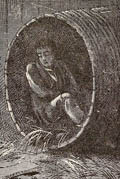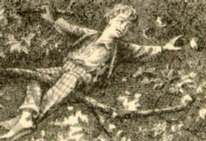
A main goal of this site is to develop new ways to organize material to explore the possibilities of an electronic archive. Each part of the site allows users to follow their interests in various directions and to varying depths. For example, clicking on the image at left will take you to one of the sites "PRETEXTS" exhibits, this one on the "Sources of Tom Sawyer." There you'll find selections from other contemporary texts about childhood, chosen to help put MT's novel in the cultural and literary context of "His Times."
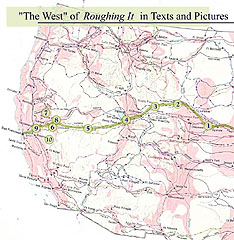
"His Times," of course, takes in a subject much too huge for any site to represent, but an electronic archive is not bound by the limits of print anthologies. In virtual reality you can store enormous amounts of material while keeping it all within the reach of the fingers on the keyboard or mouse. In the site's ROUGHING IT section are dozens of texts and hundreds of images from accounts of the American "West" published between the time MT first went west himself (1861) and the appearance of his book (1872), organized according to the route he followed and the narrative of Roughing It. Thus by clicking on the icon above left you can see how, for example, MT's account of Native Americans (and its accompanying illustrations) compares to other contemporary words and pictures.
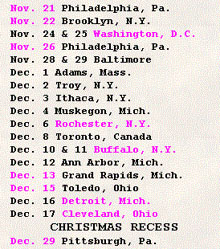
There are also specific exhibits designed to give users as much interactive control as possible. In the site's MARK TWAIN ON STAGE section, for example, the hypertext schedules of MT's major American lecture tours let you "attend" different performances from either the audience's side (by clicking on reviews in various local papers) or the entertainer's (by reading from letters MT wrote while on tour). The link at left leads to the schedule of the 1884-1885 reading tour that MT arranged to promote Huck Finn.
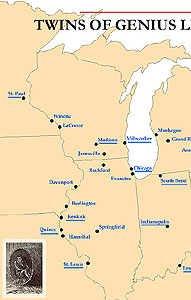
Or you can follow MT on his lecture tours a different way. This icon (left) links to a set of maps in the MARK TWAIN ON STAGE section showing the stops on seven of MT's North American speaking tours between 1866 and 1895. These maps are interactive too, allowing users to access the archive's lecture reviews geographically. They also make it possible to appreciate graphically just what parts of the country MT visited to perform live for his audience -- and (also part of the story of his relationship to his time and place) what parts he never spoke to in person.
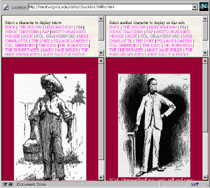
The agility with which computers can display graphics pushes us to think about the stories pictures tell. Clicking on the icon at left will take you to an interactive exhibit in the HUCK FINN section that allows you to create your own comparisons of the novel's original illustrations to see what they reveal about the way character was constructed in MT's times according to preconceptions about race, class and gender.
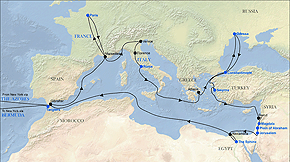
Once texts are on-line, it is also possible to display and even to conceptualize them anew. The map at left displays the route MT took in 1867 on the Quaker City pilgrimage to Europe and the Holy Land. It's also (as you'll see by clicking on it) a hypertext map of Innocents Abroad that redeploys MT's narrative in terms that are spacial, non-linear, and also geographical, racial and ethnic. "Plotting" texts in such formats enables a reader to explore and perhaps appreciate their meaning or achievement in new ways.
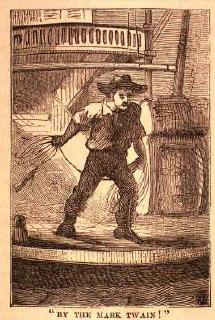
One of the best and most interactive features of an electronic text is its "searchability." There is a lot to be learned from the kinds of information a computer search can provide. How often specific words or phrases are used in a book, where they appear, what words or phrases they are associated with -- students can use that information to begin researching papers and readers can use it to confirm interpretive impressions. (It's interesting, for example, to compare the number of times forms of the words "free" and "slave" appear in Huck Finn, and then to compare both again with their appearances in Pudd'nhead Wilson.) You can search the many MT texts in this site, and all the reviews of them and of his live performances, by clicking on the image at left.
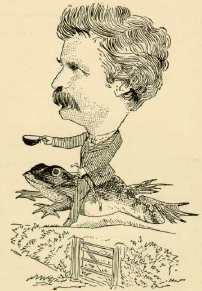
The frog at left is from a poster for one of MT's live performances. In his times MT was as well known for his lectures and speeches and one-liners as for his books. Tens of thousands of people around the world heard him in person, and hundreds of thousands more had an idea what he sounded like, because few who heard him failed to comment on his very distinctive voice. We can't ever hear "Mark Twain," but if your computer is equipped to play audio files you can, in the ON STAGE portion of this site, hear four modern Mark Twain impersonators give their lovingly recreated versions of "His Voice."
